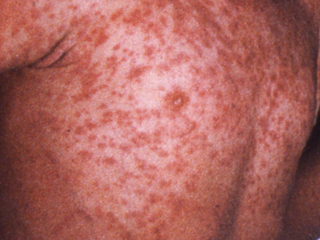Measles is viral disease arising from the Paramyxovirus group of RNA viruses which I have never encountered in my The Woodlands dermatology and Conroe dermatology offices due to the U.S. immunization program but can occasionally be seen in patients from foreign countries. Measles usually occurs in children under 15 months of age living in third world countries. It is spread by the respiratory route and has an incubation period of 9 to 12 days. Initially, patients develop a prodrome of fever, malaise, conjunctivitis, and upper respiratory symptoms such as nasal congestion/sneezing/coughing. A few days after this prodrome, the rash begins with red macules on the scalp and behind the ears. The rash progresses cephalo-caudally (from head to toe) as it spreads down the face, trunk and extremities until the whole body is affected. The rash is described as “morbilliform” and other rashes unrelated to measles are described using this term. Koplik spots are pathognomonic and are found during the prodrome. They are white papules on a red base which are found on the buccal mucosa near the lower molars. Some patients may develop otitis media, pneumonia, and encephalitis. A cell blood count usually reveals a low white blood count with lymphopenia (low lymphocytes). Children under age 1 can be treated with an immune serum globulin and high dose Vitamin A can be administered in infected patients.






